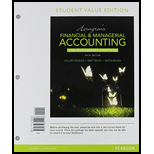
Trading Investments:
Trading investments are the investments in debt or equity securities where the investor holds less than 20% of the voting stock. The investor wishes to sell these investments at a short notice like in a few days, week, or months to generate some profit out of it. They are treated as current assets.
To identify: How the given investment would be classified.
Answer to Problem 1QC
When the investor invests in the debt or equity securities, holding less than 20% of the voting stock of the investee company, in view of selling them in the near future, then such investment is known as a trading investment.
Hence, the correct answer is option b. Trading investment.
Explanation of Solution
Justification for incorrect answers:
Option a. Significant interest investments are the equity securities where an investor holds more than 20%, but less than 50% of the voting stocks. Here, Railway I (investor) will own only 5% of the voting stock of Company P. Hence, option a. is incorrect answer.
Option b. Trading investments are short-term securities where the investor owns less than 20% of the voting stock of the investee company which are bought to sell in the near future to generate profits.
The investment made by Railway I is a trading investment as it represents 5% of voting stocks and investment was made for 3 months.
Option c. Held-to-maturity investment is the investment which is held till their maturity date. Here, Railways I is not planning to hold the investment till maturity, but is planning to hold them for only three months. Hence, option c. is an incorrect answer.
Option d. Controlling interest investments are the equity securities where an investor holds more than 50% of the voting stocks. Here, Railway I will hold only 5% of the voting stock of the investee company. Hence, option d, is an incorrect answer.
Justification for correct answer:
Option b. As the investor company (Railway I) is considering investing in the investee company (Company P) for a short period (three months), and the investment will represent less than 20% of the voting stock (5%) of the investee company, then such investment would be classified as a trading investment.
Hence, option b. is the correct answer.
Want to see more full solutions like this?
Chapter 10 Solutions
Horngren's Financial & Managerial Accounting, The Managerial Chapters, Student Value Edition Plus MyLab Accounting with Pearson eText -- Access Card Package (5th Edition)
- What information goes on the financial system? And please give an example.arrow_forwardMit Distributors provided the following inventory-related data for the fiscal year: Purchases: $385,000 Purchase Returns and Allowances: $10,200 Purchase Discounts: $4,300 Freight In: $55,000 Beginning Inventory: $72,000 Ending Inventory: $95,500 What is the Cost of Goods Sold (COGS)?arrow_forwardanswer ? general accountingarrow_forward
- BrightTech Corp. reported the following cost of goods sold (COGS) figures over three years: • 2023: $3,800,000 • 2022: $3,500,000 • 2021: $3,000,000 If 2021 is the base year, what is the percentage increase in COGS from 2021 to 2023?arrow_forwardSun Electronics operates a periodic inventory system. At the beginning of 2022, its inventory was $95,750. During the year, inventory purchases totaled $375,000, and its ending inventory was $110,500. What was the cost of goods sold (COGS) for Sun Electronics in 2022?arrow_forwardi want to this question answer of this general accountingarrow_forward
- A clothing retailer provides the following financial data for the year. Determine the cost of goods sold (COGS): ⚫Total Sales: $800,000 • Purchases: $500,000 • Sales Returns: $30,000 • Purchases Returns: $40,000 • Opening Stock Value: $60,000 • Closing Stock Value: $70,000 Administrative Expenses: $250,000arrow_forwardsubject : general accounting questionarrow_forwardBrightTech Inc. had stockholders' equity of $1,200,000 at the beginning of June 2023. During the month, the company reported a net income of $300,000 and declared dividends of $175,000. What was BrightTech Inc.. s stockholders' equity at the end of June 2023?arrow_forward
- Question 3Footfall Manufacturing Ltd. reports the following financialinformation at the end of the current year: Net Sales $100,000 Debtor's turnover ratio (based on net sales) 2 Inventory turnover ratio 1.25 fixed assets turnover ratio 0.8 Debt to assets ratio 0.6 Net profit margin 5% gross profit margin 25% return on investments 2% Use the given information to fill out the templates for incomestatement and balance sheet given below: Income Statement of Footfall Manufacturing Ltd. for the year endingDecember 31, 20XX(in $) Sales 100,000 Cost of goods sold gross profit other expenses earnings before tax tax @ 50% Earnings after tax Balance Sheet of Footfall Manufacturing Ltd. as at December 31, 20XX(in $) Liabilities Amount Assets Amount Equity Net fixed assets long term debt 50,000 Inventory short term debt debtors cash Total Totalarrow_forwardi need correct answer of this general accounting questionarrow_forwardStockholders' equity increasedarrow_forward
 Financial Reporting, Financial Statement Analysis...FinanceISBN:9781285190907Author:James M. Wahlen, Stephen P. Baginski, Mark BradshawPublisher:Cengage Learning
Financial Reporting, Financial Statement Analysis...FinanceISBN:9781285190907Author:James M. Wahlen, Stephen P. Baginski, Mark BradshawPublisher:Cengage Learning Pfin (with Mindtap, 1 Term Printed Access Card) (...FinanceISBN:9780357033609Author:Randall Billingsley, Lawrence J. Gitman, Michael D. JoehnkPublisher:Cengage Learning
Pfin (with Mindtap, 1 Term Printed Access Card) (...FinanceISBN:9780357033609Author:Randall Billingsley, Lawrence J. Gitman, Michael D. JoehnkPublisher:Cengage Learning


